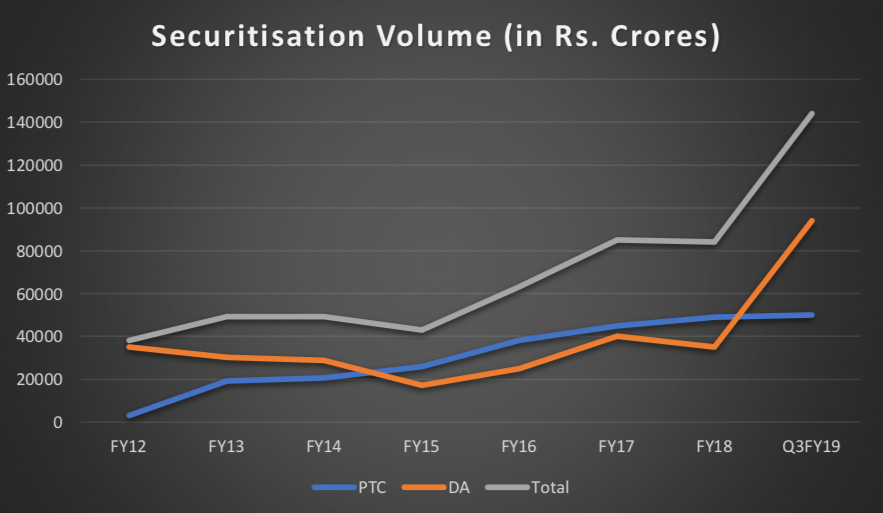[Vineet Ojha is Manager – IFRS & Valuation Services at Vinod Kothari Consultants Pvt Ltd]
The current financial year has witnessed a sharp surge and a life time high in the volume of securitization and direct assignment transactions in the Indian economy. Consequent to the funding problems that non-banking finance companies (NBFC) and housing finance companies (HFCs) have been facing over the last few months, direct assignments of retail portfolios have picked up considerable pace, with volumes touching an all-time high of Rs. 1.44 lakh crore during the nine-month period (April-December) of financial year 2019 (FY 19). Of this, around Rs. 73,000 crore was raised by NBFCs and HFCs through sell-down of their retail and small and medium enterprises (SME) loan portfolio to various investors (primarily banks). Investor appetite, particularly from public sector banks and private banks, is high at present, considering investors are not exposed to entity-level credit risk, and are seen taking exposure to the underlying pool of retail and SME borrowers. Yields have gone up significantly with the changing market dynamics. The momentum in the securitization market is likely to remain strong in the current fiscal as it is emerging as an important tool for retail-focused NBFCs for raising funds at reasonable costs while simultaneously providing a hedge against asset-liability mismatches. A visual trend of the market over the years can be seen below:

Source: India Securitization Market: Booklet by VKCPL
Why the sudden surge?
Looking at the figure above, we can see a sharp surge in the direct assignment volumes in FY19. A majority of the issuances comes from the third quarter with around Rs. 73,000 crores. Although the major driver is the Infrastructure Leasing and Financial Services Limited (IL&FS) imbroglio, it is not the only reason for this development.
IL&FS crisis
Following the IL&FS crisis, the Reserve Bank of India (RBI) has time and again prompted banks to assist NBFCs to recover from the cash crunch. However, wary of the credit quality of the NBFCs and HFCs, the banks have shown more interest in the underlying loan portfolios than on the originator itself. Through direct assignment and securitization, these institutions get upfront cash payments against selling their loan assets. This helps these institutions during the cash crunch. Funds raised by NBFCs and HFCs through this route helped the financiers meet sizeable repayment obligations of the sector in an otherwise difficult market.
RBI relaxes MHP norms for long tenure loans
Another reason that explains this sudden surge in the volume of direct assignment or securitization volumes is the relaxation of the minimum holding period (MHP) criteria for long-tenure loans by the RBI. This increased the quantum of assets eligible for securitization in the system. The motivation was the same is to encourage NBFCs and HFCs to securitize their assets to meet their liquidity requirements. More details about this can be found here.
Effects of Securitization
Primarily, priority sector lending (PSL) requirements were the primary drivers for securitization. The number of financial institutions participating in securitization were quite low. Now, for liquidity concerns, NBFCs and HFCs were forced to rely on securitization to meet their liquidity needs. This not only made them explore a new mode of funding, but also solved other problems like asset liability mismatches. In the nine months of FY19 and FY18, the share of non-PSL transactions has increased to 35 per cent compared to 24 per cent in FY17 and less than 20 per cent in the periods prior to that.
However, it is not a rosy picture all over. Due to the implementation of IFRS, upon de-recognition of a loan portfolio from the financial statements of the company, the seller shall have to recognize a gain on sale on the transaction. These gains disturb the stability of the profit trend in these financial institutions which would result in volatile earnings in their statements. The NBFCs have been trying to figure out solutions which would allow them to spread the gain on transfer over the life of the assets instead of booking it upfront.
Conclusion
The securitization market remained buoyant in the third quarter driven by the prevailing liquidity crisis following defaults by IL&FS and its subsidiaries. This surge is good for the Indian securitization market as India’s contribution to global securitization market, at about USD 12 billion, is barely recognized, for two reasons – firstly, India’s market has so far been largely irrelevant for the global investors, and secondly, bulk of the market has still been driven by PSL requirements. PSL-based securitizations obviously take place at rates which do not make independent economic sense. Now due to the surge in non-PSL based securitization, the rates at which the portfolios are sold are attractive to investors. This could attract global investors to the market.
Now that financial institutions have gained exposure to the securitization markets, they find that the transactions are attractive for sellers as well as investors. Our interaction with leading NBFCs reveals that there are immediate liquidity concerns. Banks are not willing to take on-balance sheet exposure on NBFCs; rather they are willing to take exposure on pools. Capital relief and portfolio liquidity are additional motivations for the originators (and other potential investors) to enter into securitization transactions.
– Vineet Ojha
